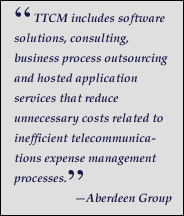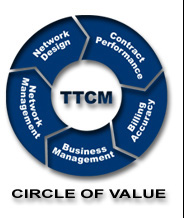




TTCM Savings Area:
Contract Performance
Published In: Volume
3 Issue 5
Date: October,
2004
|
How many times have you returned from the store, only to realize that you've forgotten to purchase some of the items you need? Everybody remembers the milk and eggs, but what about the garlic salt and blackberry jam? When you're buying groceries, it's merely an inconvenient return trip. If you're buying telecom services, your next trip may be years away. Here are some
very important recommendations to insure that your shopping list
for communication services is complete when you head to the "store".
Whether you're shopping for groceries or telecom, you've got to build a thorough list, especially with LD services where companies face widely varying call patterns that result in hundreds of unique call types. Leave something off the shopping list, and you'll probably have to pay boutique convenience store prices later rather than bulk Costco rates now. Here's a chart to demonstrate just how quickly the number of call types can grow. Although no company would realistically have the full 1,212 domestic call types, we have seen companies that will approach 100. Factor in international traffic, and the list just grows. As you can see, the list begins by breaking with the 4 primary Access categories, then takes into account Jurisdictions, Service and Type.
When shopping for telecom services, all too frequently companies leave something important off the list. Common examples are Switched Data Services (used for video conferencing or dial back-up), or favorable intrastate rates for a regional sales office.
In addition to all of the permutations shown on the table, there are other charge categories to be added to your shopping list. If you run a call center, for example, be sure to verify pricing for all the inbound features such as Real Time ANI of Transactional CAPability (TCAP) Queries as well as fixed monthly charges for toll free numbers. Another cost category to watch is surcharges, as surcharge costs for calling cards and other items can vary greatly between vendors, amounting to thousands of dollars per month.
We recommend evaluating your usage for a minimum of 3 months, longer if possible. Make sure that all locations are included in your analysis. Carefully document all call patterns in detail, including number of calls, durations and current costs. This usually requires tedious work examining call detail records from billing CD's to identify each call type that carries a unique rate. Once this list has been compiled, rank each call type by cost and usage to determine which ones merit the time to negotiate incremental savings.
Today's world is sure to be different tomorrow, so it is important to ask questions outside of the telecom department as to where your business is headed. Is there a planned expansion in the Asian market? Are your call centers about to go overseas, or come back home? Is your I.T. department planning on installing dial-up video conferencing in order to reduce employee travel? These types of changes will often dramatically change your spend patterns.
No matter how complete your list, you won't be able to cover every eventuality, so work hard to build flexibility into your contract. One way is to negotiate global or fixed discounts for all non-specified call types. That at least gives you some protection against paying full boat. Next, be sure to eliminate any "lock-ins" that may be lurking in the fine print such as exclusivity clauses. These little nasties will prevent you from shopping for best possible rates on call types that emerge down the road. Another no-no is an excessively high MARC that ties you to a vendor just to avoid shortfall penalties.
Just because a contract will be in force for the foreseeable future, it doesn't mean you can't improve your situation. Use the same techniques to track your calling patterns and see if anything unexpected has occurred that might be unfavorable to your situation. In the event you identify non-contracted call types, take them to your vendor and ask for contract changes to reflect your current situation. Any vendor that doesn't want to keep your long-term business by addressing current issues is laying the foundation for a future "lost customer". If they stand firm, remind them of your long memory when the contract expires. Now, if you'll excuse me, I need to run back to the store for that garlic salt.
©2004,
TelAssess, Inc. All rights reserved. |
||||||||||||||||||||||||||||||||||||||||||||||||||||||||||||
![]()
©2004, TelAssess 800.657.1595
Designed by Stylus
Designs
